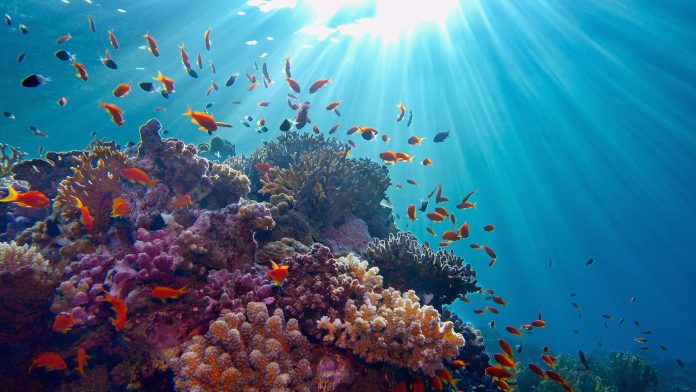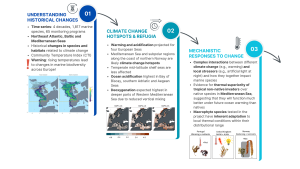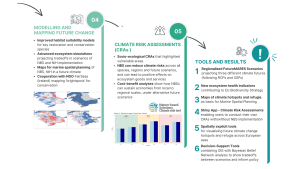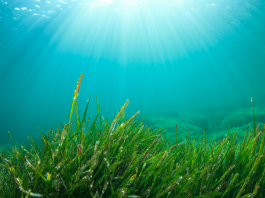Determined to secure the future of the marine ecosystems, the EU project, FutureMARES, is using nature-based solutions to better understand, document and rebuild marine biodiversity.
Climate change (CC) and human activities accelerate the loss of marine biodiversity. The loss of biodiverse habitats leads to losses in important ecosystem services and cultural benefits. Luckily, nature itself offers solutions to these problems.
By implementing so-called Nature-based Solutions (NBS), we can better conserve and actively restore the health of marine ecosystems and their commercially and culturally important natural capital. NBS can work hand-in-hand with Nature-inclusive (sustainable) Harvesting (NIH) of marine resources to safeguard a host of ecosystem services, and this is where the FutureMARES project comes into play.
Our 33 project partners have cooperated with regional stakeholders in 39 Case Studies across Europe and beyond to provide science-based advice for regional and local CC adaptation and mitigation actions through the implementation of NBS. Successful, long-term rebuilding of biodiversity using NBS requires knowledge of the physical and chemical changes that have already occurred in the oceans, the ecological losses they have caused, and what is likely to happen in the years to come.
Unprecedented changes in marine biodiversity
FutureMARES has thoroughly documented historical changes in marine species and habitats that can be attributed to CC. Environmental time series of up to four decades from 65 monitoring programmes, including historical data for 1,817 marine species (zooplankton, benthos, pelagic and demersal invertebrates and fish) were analysed by calculating the Community Temperature Index (CTI). The CTI is a standardised indicator that provides quantitative information on species composition and its affinity for warm or cold waters.
Over the past 40 years, the north-east Atlantic Ocean has experienced a tropicalisation of its communities, with an increase in the abundance of warmer-water species, while the Mediterranean and Baltic Seas, where warming has been more rapid, have seen a marked decline in cold-water organisms.
The study, published in Nature Communications, warns of continued changes in the marine biodiversity of European seas and oceans when temperatures continue to increase. These alarming trends have potential economic and social consequences and highlight the importance of NBS for climate adaptation and mitigation.
Improved projections of future climate-driven changes
To offer the best possible information for decision-making, FutureMARES developed climate projections of local-scale impacts of CC in coastal zones and shelf seas, along with valuable information on their uncertainty. The datasets deliver monthly changes from 1993 to 2100 in five ocean indicators (temperature, salinity, pH, oxygen and chlorophyll) at different depths at a resolution of about 8km for four European regions: North Sea, Baltic Sea, Bay of Biscay and the Mediterranean Sea and two overseas territories considered in the project (the Chilean coast and Yucatan peninsula).
Published in Scientific Reports, these projections identify the compound pressures of warming, acidification and deoxygenation on European regional seas and identify future CC hotspots as well as refugia for sensitive species.
While changes in pressures were variable, both within and among regional seas, the projections underscore how policy interventions that decrease greenhouse gas concentrations can substantially reduce unwanted physical and biogeochemical impacts.
New knowledge on climate sensitivity of key marine species and habitats
FutureMARES performed field and laboratory experiments to advance knowledge on the sensitivity of key habitat-forming species to climate-driven and other stressors. In the Mediterranean Sea, results provide evidence for the thermal superiority of tropical non-native invaders over native species, suggesting bio-invaders will perform much better under future ocean warming than natives.
Results also show that alien-dominated, altered but rich, or restored macrophyte communities on shallow reefs can function similarly or superiorly to the original communities, providing some hope that even highly altered communities may continue to provide functions and services important to the health of the marine ecosystem.
FutureMARES showcased the response of habitat-forming species to climate-driven warming plus artificial light at night. Experiments revealed population differences in climate sensitivity with inherent adaptation to local thermal conditions.
This may suggest some hope for acclimation or for selection towards more resilient genotypes in a future climate. These population differences have implications for the robustness of species distribution models, the selection of sites for marine protection, and the climate resilience of habitat restoration.
The new climate change projections and knowledge of climate sensitivity have allowed FutureMARES to create maps of the future distribution and productivity of key species and habitats. These maps help build the strong scientific foundation needed for planning Marine Protected Areas (MPAs) networks. Cooperation with the NGO FairSeas resulted in the mapping of climate change hotspots and refugia in Irish waters, contributing to that nation’s commitment to the EU 2030 Biodiversity Strategy.
FutureMARES also advanced and applied marine ecosystem models. These simulations test the ecological and economic benefits of effective habitat restoration and networks of MPAs and how more stringent protection (now planned for 10% of MPAs) combined with NIH (reduction in bycatch rates and fishing effort) can lead to the recovery of key commercial and conservation species. Our results suggest that NBS, together with NIH actions, may play a vital role in climate adaptation and mitigation and in safeguarding marine biodiversity.
Tools for decision-makers and scientists
FutureMARES performed socio-ecological climate risk assessments (CRAs) that highlighted vulnerable areas such as the eastern Mediterranean and demonstrated how risks to species, ecosystem services, and social groups increase without NBS. Implementing NBS reduced climate risks across all species, regions and future scenarios and led to positive effects on ecosystem goods and services.
The analysis also revealed that NBS can be less effective under IPCC scenarios with high greenhouse gas concentrations. Cost-benefit analyses show how NBSs can sustain economies from local to regional scales under alternative future scenarios. FutureMARES produced a CRA App guiding users on how to conduct these analyses.
FutureMARES has also developed spatially explicit tools that display not only areas where CC is most likely to drive ecosystems towards a new state (CC hotspots) but also areas offering opportunities, such as the range expansion of species to foster sustainable growth (CC bright spots).
Additional decision support tools combining GIS with Bayesian network analysis were designed to visualise trade-offs between scenarios to inform users about interactions among different ecosystem components and human activities to assess marine ecosystem services.
Policy impact
Working with decision-makers, policymakers, and environmental managers, FutureMARES has provided the science-based advice needed to implement NBS and NIH as part of regional and local climate change adaptation and mitigation actions.
The results of FutureMARES will strongly contribute to national, EU, and global reports and policies to safeguard and restore marine biodiversity, helping to meet the targets of the EU 2030 Biodiversity Strategy and Nature Restoration Law.
FutureMARES also proposes revisions to the EU Marine Strategy Framework Directive, recommending several improved ecological indicators of good environmental status (GES) and the inclusion of social-economic indicators for marine species and habitat conservation, habitat restoration, and the sustainable harvesting of seafood.
To learn how to use our results and products, visit our FutureMARES website or get in touch with us directly using the contact information below.
Disclaimer
![]() This project receives funding from the European Union’s Horizon 2020 research and innovation programme under grant agreement No 869300.
This project receives funding from the European Union’s Horizon 2020 research and innovation programme under grant agreement No 869300.
Authors
- Myron A Peck – Royal Netherlands Institute for Sea Research (NIOZ-Texel)
- Juan Bueno-Pardo – Marine Research Center (CIM), University of Vigo
- Fabio Bulleri – Department of Biology, University of Pisa
- Momme Butenschon – Euro-Mediterranean Center on Climate Change (CMCC)
- Guillem Chust – AZTI Marine Research, Basque Research and Technology Alliance (BRTA)
- Josefina Cordera – Royal Netherlands Institute for Sea Research (NIOZ-Texel)
- Vera Köpsel – University of Hamburg
- Christopher Lynam – Centre for Environment, Fisheries and Aquaculture Science (Cefas)
- Gill Rilov – National Institute of Oceanography, Israel Oceanographic and Limnological Research (IORL)
Please note, this article will also appear in the 18th edition of our quarterly publication.











